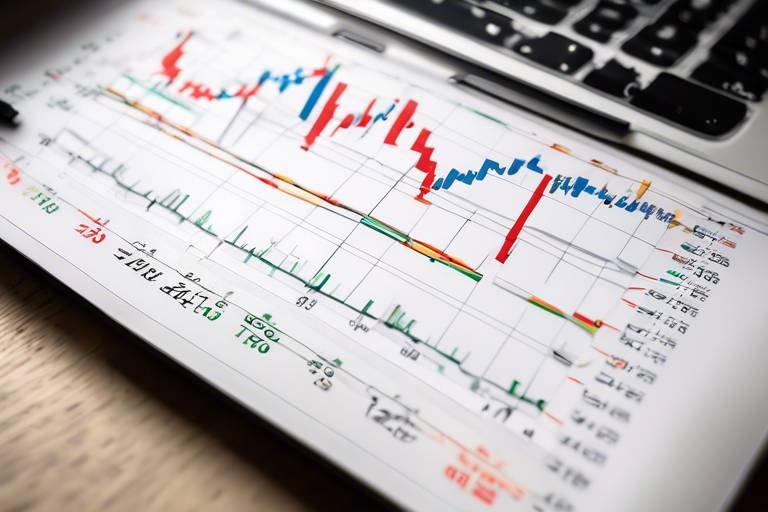How to Leverage Market Analysis for Day Trading Success
In the fast-paced world of day trading, having a solid grip on market analysis can be your secret weapon. Imagine navigating through the financial markets like a skilled sailor steering through turbulent waters; market analysis is your compass, guiding you toward profitable trades. With the right strategies, you can interpret data, identify trends, and make informed decisions that elevate your trading game. This article delves into effective methods to leverage market analysis, ensuring you're not just another trader lost at sea.
Market analysis is more than just a buzzword; it’s the cornerstone of successful trading. It involves evaluating various factors that influence financial markets, from economic indicators to market sentiment. By grasping these fundamentals, traders can better predict price movements and refine their trading strategies. Think of market analysis as the lens through which you view the market; the clearer your lens, the better your vision of potential opportunities. With this understanding, you can transform your trading approach from guesswork to informed decision-making.
When it comes to market analysis, there are three primary types that every trader should be familiar with: fundamental analysis, technical analysis, and sentiment analysis. Each of these approaches offers unique insights that can significantly impact your trading decisions. By integrating these analyses into your trading routine, you can create a comprehensive strategy that maximizes your chances of success.
Fundamental analysis is like peering beneath the surface of the market to uncover the underlying factors that drive asset prices. This approach focuses on economic indicators, financial statements, and news events that can sway market sentiments. Understanding these elements helps traders gauge the overall market health and make strategic trades. For instance, economic indicators such as GDP growth, unemployment rates, and consumer confidence play a crucial role in shaping market trends. Staying updated on these metrics allows traders to anticipate market movements effectively.
Economic indicators are the pulse of the market. They provide insights into the economic landscape and help traders make sense of market fluctuations. Here are some key indicators to keep an eye on:
- Gross Domestic Product (GDP): Measures the overall economic output and growth.
- Unemployment Rates: Indicates the health of the job market and consumer spending potential.
- Consumer Confidence Index: Reflects how optimistic consumers feel about the economy.
By monitoring these indicators, traders can position themselves advantageously in the market, anticipating potential price movements before they happen.
In addition to economic indicators, company-specific news can have a profound impact on stock prices. Events such as earnings reports, product launches, and management changes can create significant volatility in the market. For example, a company announcing better-than-expected earnings can lead to a surge in its stock price, while negative news can trigger a decline. Therefore, keeping a close watch on relevant news can provide traders with opportunities to capitalize on price changes.
While fundamental analysis helps you understand the 'why' behind market movements, technical analysis focuses on the 'how.' This approach relies on historical price data and chart patterns to forecast future price movements. By studying trends and identifying key support and resistance levels, traders can pinpoint optimal entry and exit points for their trades. It’s like being a detective, piecing together clues from past market behavior to solve the mystery of future price action.
In today’s digital age, trading software is an essential tool for any serious trader. These platforms provide real-time data analysis, charting capabilities, and automated trading options that can enhance decision-making and streamline the trading process. Leveraging these tools can give you a competitive edge, allowing you to react swiftly to market changes.
Charting tools are your visual aids in the trading world. They allow you to visualize price movements and identify patterns that may not be immediately apparent. Understanding how to use these tools effectively can lead to more informed trading decisions. By analyzing historical trends, you can forecast potential price movements and make strategic trades that align with your trading goals.
For traders looking to capitalize on market opportunities without the need for constant monitoring, automated trading systems can be a game-changer. These systems execute trades based on predefined criteria, allowing you to take advantage of market movements even when you’re not actively trading. Think of it as having a personal assistant who executes your trading strategy while you focus on analyzing the market.
Q: What is market analysis?
A: Market analysis involves evaluating various factors that influence financial markets to predict price movements and improve trading strategies.
Q: What are the main types of market analysis?
A: The three primary types are fundamental analysis, technical analysis, and sentiment analysis.
Q: How can trading software help me?
A: Trading software provides tools for real-time data analysis, charting, and automated trading, enhancing decision-making and streamlining the trading process.

Understanding Market Analysis
Market analysis is the backbone of successful trading. It involves a deep dive into various factors that influence the financial markets, acting as a compass that guides traders through the often turbulent waters of day trading. By understanding market analysis, you can significantly enhance your trading strategies and improve your chances of making profitable decisions. Think of it as a treasure map; without it, you might just be wandering aimlessly in search of gold.
At its core, market analysis is about evaluating data and trends to predict price movements. This isn’t just about looking at numbers on a screen; it's about interpreting them in a way that reveals the underlying story of the market. Just like a detective piecing together clues to solve a mystery, traders analyze various elements—economic indicators, company news, and historical price data—to gain insights that can lead to successful trades.
One of the most fascinating aspects of market analysis is its dynamic nature. The markets are constantly changing, influenced by a myriad of factors such as economic reports, geopolitical events, and shifts in investor sentiment. This means that a trader must stay alert and adaptable, ready to adjust their strategies based on the latest information. Imagine being in a fast-paced race; you wouldn’t want to be stuck in the slow lane while others zoom past you because they have better intel on the track ahead.
Moreover, understanding market analysis is not just about gathering data; it’s about synthesizing that information into actionable insights. For example, when analyzing economic indicators, a trader might look at how changes in GDP or unemployment rates can signal potential market movements. This requires a blend of analytical skills and intuition, as sometimes the numbers alone won’t tell the whole story. You have to read between the lines and consider the broader context.
In essence, mastering market analysis can set you apart from the crowd. It empowers you to make informed decisions rather than relying on gut feelings or hearsay. By understanding the fundamentals of market analysis, you can better predict price movements, identify trends, and ultimately improve your trading performance. So, whether you’re a seasoned trader or just starting, investing time in understanding market analysis is a crucial step toward achieving day trading success.

Types of Market Analysis
When it comes to day trading, understanding the is crucial for developing a successful trading strategy. Each type provides unique insights that can help traders make informed decisions. Essentially, we can categorize market analysis into three primary types: fundamental analysis, technical analysis, and sentiment analysis. By grasping the nuances of each type, traders can enhance their ability to predict price movements and optimize their trading outcomes.
Let’s dive deeper into these three types. First up is fundamental analysis. This approach focuses on evaluating the economic factors and company-specific events that influence asset prices. Think of it as trying to understand the health of a company or an economy by looking at its vital signs—just like a doctor checks your pulse and blood pressure. Traders who use fundamental analysis keep an eye on economic indicators such as GDP growth, unemployment rates, and inflation. These metrics provide a snapshot of market conditions and are essential for making strategic trades.
Next, we have technical analysis. This method is like being a detective, piecing together clues from historical price data and chart patterns to forecast future price movements. Technical analysts examine charts to identify trends, support and resistance levels, and various indicators that signal potential entry and exit points. For instance, if a trader notices a consistent upward trend in a stock’s price, they might consider it a good time to buy, thinking that the trend will continue. The beauty of technical analysis lies in its ability to provide visual representations of price movements, making it easier to spot opportunities.
Finally, let’s talk about sentiment analysis. This type digs into the emotional and psychological factors that influence market behavior. It’s like reading the mood of a crowd—are they feeling bullish or bearish? Traders often gauge sentiment through various means, such as analyzing social media chatter, news headlines, and market surveys. A surge in positive sentiment might prompt traders to buy, while negative sentiment could lead to selling. Understanding market sentiment can be the key to staying ahead of the curve and making timely trades.
In summary, each type of market analysis offers valuable insights that can significantly impact trading decisions. By combining fundamental, technical, and sentiment analysis, traders can create a more holistic view of the market, leading to better-informed strategies and ultimately, greater trading success. Remember, the market is like a puzzle, and understanding these different types of analysis is essential to putting the pieces together effectively.
- What is the best type of market analysis for day trading?
There isn't a one-size-fits-all answer, as different traders may prefer different types based on their trading style. However, many successful day traders often use a combination of technical and sentiment analysis for quick decision-making.
- How can I start learning about market analysis?
Begin by reading books and articles on trading strategies, following market news, and practicing with demo accounts. Online courses and webinars can also provide valuable insights.
- Is it necessary to use all three types of analysis?
While it's not mandatory, using all three types can provide a more comprehensive understanding of the market, helping you make well-rounded trading decisions.

Fundamental Analysis
Fundamental analysis is like the detective work of the trading world. It dives deep into the underlying factors that influence asset prices, focusing on economic indicators, company performance, and significant news events. Think of it as peeling back the layers of an onion to reveal the core of what drives market movements. By understanding these elements, traders can gauge the overall health of the market and make more strategic trading decisions.
To effectively utilize fundamental analysis, one must keep an eye on various economic indicators. These indicators serve as vital signs for the economy, providing insights into its current state and potential future movements. For instance, metrics like Gross Domestic Product (GDP), unemployment rates, and consumer confidence can paint a broad picture of economic health. If GDP is growing steadily, it often signals a robust economy, which can lead to increased consumer spending and, consequently, higher stock prices. Conversely, rising unemployment rates may indicate economic trouble, prompting traders to adjust their strategies accordingly.
In addition to economic indicators, company-specific news plays a crucial role in fundamental analysis. Events such as earnings reports, product launches, and even changes in management can have a significant impact on stock prices. For example, if a company reports earnings that exceed market expectations, its stock price may soar, presenting an opportunity for traders to capitalize on that momentum. Therefore, staying updated on such developments is essential for making informed trading decisions.
Furthermore, traders should also pay attention to macroeconomic factors, such as interest rates and inflation. These elements can influence investor sentiment and market dynamics. When interest rates rise, borrowing costs increase, which can dampen consumer spending and slow down economic growth. On the other hand, low-interest rates can stimulate borrowing and investment, potentially leading to higher stock prices.
In summary, fundamental analysis is a vital tool for traders seeking to understand the market's underlying forces. By analyzing economic indicators, company news, and macroeconomic factors, traders can make informed decisions that enhance their chances of success in the fast-paced world of day trading. Remember, knowledge is power, and in the realm of trading, being informed can set you apart from the competition.
Key Takeaways:
- Fundamental analysis helps traders understand the underlying factors affecting asset prices.
- Economic indicators like GDP and unemployment rates are crucial for assessing market health.
- Company-specific news can significantly influence stock prices.
- Macroeconomic factors such as interest rates and inflation also play a vital role.
To wrap things up, here are some frequently asked questions about fundamental analysis in day trading:
- What is fundamental analysis?
Fundamental analysis evaluates economic indicators, company performance, and news events to predict asset price movements. - Why is it important for day traders?
It helps traders make informed decisions based on the underlying health of the market and specific assets. - How can I stay updated on economic indicators?
Regularly check financial news websites, subscribe to economic calendars, and follow reputable financial analysts on social media.

Economic Indicators
When diving into the world of day trading, serve as your compass, guiding you through the often tumultuous waters of the financial markets. These indicators are essentially statistical data points that provide insight into the economic health of a country. Think of them as the heartbeat of the economy; when they pulse strongly, traders feel confident, but when they falter, caution is the name of the game.
Some of the most critical economic indicators include Gross Domestic Product (GDP), unemployment rates, and consumer confidence indexes. Each of these plays a pivotal role in shaping market sentiment and influencing trading decisions. For instance, a rising GDP often signals a growing economy, which can lead to increased consumer spending and, consequently, higher stock prices. On the flip side, a spike in unemployment rates might indicate economic distress, causing traders to reassess their positions.
Let’s break down some of these indicators:
- Gross Domestic Product (GDP): This measures the total value of all goods and services produced in a country. A growing GDP suggests a healthy economy, while a shrinking GDP can be a red flag.
- Unemployment Rate: This percentage indicates the number of unemployed individuals actively seeking work. A high unemployment rate can lead to decreased consumer spending, negatively impacting the market.
- Consumer Confidence Index: This reflects how optimistic or pessimistic consumers are about the economy's current and future state. High consumer confidence often correlates with increased spending and investment.
Traders must stay updated on these metrics, as they can significantly impact market movements. For example, if the GDP reports a robust growth rate, traders might rush to buy stocks, anticipating a bullish market. Conversely, if unemployment claims rise unexpectedly, it could trigger a sell-off as traders brace for potential downturns.
In addition to these key indicators, it’s also essential to consider central bank policies, such as interest rate changes. Interest rates can influence borrowing costs and consumer spending, making them a vital component of economic analysis. For instance, when central banks lower interest rates, it typically encourages borrowing and spending, which can boost stock prices. On the other hand, rising rates might dampen market enthusiasm, leading traders to pull back.
In summary, understanding economic indicators is crucial for any day trader aiming for success. By keeping a close eye on these metrics and interpreting their implications, traders can make more informed decisions and navigate the market with greater confidence. So, the next time you’re preparing to make a trade, remember to check the economic pulse—your portfolio will thank you!
What are economic indicators?
Economic indicators are statistical data points that provide insights into the economic health of a country, helping traders predict market movements.
Why are economic indicators important for day trading?
They help traders gauge market sentiment and make informed decisions based on the current state of the economy.
How can I stay updated on economic indicators?
You can follow financial news websites, subscribe to economic calendars, or use trading software that provides real-time updates on economic data.

Company News and Events
When it comes to day trading, keeping an eye on is crucial. Think of the stock market as a living organism, constantly reacting to stimuli from various sources. Company news can serve as a significant stimulus, causing stock prices to jump or plummet in a matter of moments. For instance, when a company announces its quarterly earnings, the results can either excite investors or dampen their enthusiasm, leading to rapid price fluctuations. This is where traders need to be sharp and ready to act.
One of the most critical aspects of monitoring company news is understanding earnings reports. These reports provide insights into a company’s financial health and future prospects. If a company reports earnings that exceed expectations, it can lead to a surge in stock prices. Conversely, disappointing earnings can trigger a sell-off. Traders should familiarize themselves with the earnings calendar, which outlines when companies will release their reports. This way, they can prepare their strategies in advance and capitalize on potential market movements.
Additionally, product launches and announcements can dramatically impact stock prices. For example, if a tech company unveils a groundbreaking product, it could lead to a spike in investor interest and a rise in stock value. On the flip side, if a product fails to meet expectations or is delayed, traders might see a decline in stock prices. Staying informed about upcoming product launches and company announcements is essential for making timely trading decisions.
Moreover, significant events such as mergers and acquisitions can shake up the market. These events often create waves of speculation and excitement, which can lead to increased trading volume and volatility. Traders should pay attention to news surrounding potential mergers or acquisitions, as these can provide lucrative trading opportunities. For instance, if a well-established company plans to acquire a smaller one, the stock price of the smaller company may rise sharply, presenting a chance for savvy traders to profit.
In summary, the importance of monitoring company news and events cannot be overstated. By staying updated on earnings reports, product launches, and significant corporate events, traders can make informed decisions that align with market movements. In this fast-paced trading environment, being proactive rather than reactive can be the difference between a successful trade and a missed opportunity. So, keep your ears to the ground and your eyes on the news, because in the world of day trading, information is power!
- What is the best way to stay updated on company news?
Utilizing financial news websites, subscribing to newsletters, and following companies on social media can help you stay informed.
- How can I analyze the impact of news on stock prices?
Look at historical data to see how similar news events have affected stock prices in the past, and consider using technical analysis tools to identify trends.
- Should I react immediately to company news?
While it’s essential to act quickly, ensure that you analyze the news and its potential impact on the market before making any trades.

Technical Analysis
Technical analysis is like having a crystal ball for traders—it allows them to peer into the past to predict the future. By examining historical price data and chart patterns, traders can glean insights about potential future movements. Imagine trying to navigate through a dense fog without a map; that's what trading can feel like without the guidance of technical analysis. It empowers traders by providing them with the tools to identify trends, support and resistance levels, and potential reversal points.
At its core, technical analysis revolves around the belief that all relevant information is already reflected in the price of an asset. This means that by studying price movements and volume, traders can make educated guesses about where prices are headed next. For instance, if a stock has been on a steady upward trajectory, a trader might infer that this trend will continue unless something significant changes. On the flip side, if prices start to dip, it could signal a potential reversal or a market correction.
One of the most essential components of technical analysis is understanding different types of charts. The most common chart types include:
- Line Charts: These provide a simple view of price movements over time, connecting closing prices to create a line.
- Bar Charts: These offer more detail, showing the open, high, low, and close prices for a specific period.
- Candlestick Charts: These are visually appealing and provide a wealth of information at a glance, showing price movements in a way that highlights bullish and bearish trends.
Once traders are familiar with different chart types, they can begin to analyze patterns. Patterns are crucial as they often indicate future price movements. For example, a head and shoulders pattern might suggest a reversal, while a cup and handle pattern could indicate a continuation of the trend. Recognizing these patterns can be the difference between a winning trade and a losing one.
Another vital aspect of technical analysis is the use of indicators. Indicators are mathematical calculations based on price and volume data, and they help traders make sense of market conditions. Some popular indicators include:
- Moving Averages: These smooth out price data to identify trends over a specific period.
- Relative Strength Index (RSI): This measures the speed and change of price movements, indicating whether an asset is overbought or oversold.
- Bollinger Bands: These use standard deviations to create bands around the price, helping traders identify volatility and potential price reversals.
By combining these various tools and techniques, traders can develop a comprehensive technical analysis strategy. It’s important to remember that no analysis is foolproof; the market can be unpredictable. However, technical analysis provides a framework that can significantly improve decision-making. Just like a seasoned chef uses a recipe to create a delicious dish, traders can use technical analysis to craft their trading strategies.
In conclusion, technical analysis is an indispensable tool for day traders. It allows them to make informed decisions based on historical data and market trends, ultimately leading to better trading outcomes. By mastering the art of technical analysis, traders can navigate the complex world of financial markets with confidence and precision.
Q: What is the primary goal of technical analysis?
A: The primary goal of technical analysis is to evaluate price movements and volume to forecast future price trends, enabling traders to make informed trading decisions.
Q: How can I start using technical analysis as a beginner?
A: Start by familiarizing yourself with different chart types and basic patterns. Use demo accounts to practice analyzing charts and applying indicators without financial risk.
Q: Are there any specific indicators I should focus on?
A: Beginners often find moving averages and the RSI to be useful starting points. As you gain experience, you can explore more complex indicators.
Q: Can technical analysis guarantee profits?
A: No, technical analysis cannot guarantee profits. It is a tool that helps traders make educated guesses based on historical data, but the market can be unpredictable.

Utilizing Trading Software
In today's fast-paced trading environment, has become a game changer for day traders. Imagine trying to catch a wave without a surfboard; that’s what trading without the right tools feels like! Trading software equips you with the necessary resources to analyze data in real-time, allowing you to make quick and informed decisions. The right software can help you stay ahead of the curve, giving you a competitive edge in the bustling marketplace.
One of the major advantages of trading software is its ability to provide real-time data analysis. Gone are the days of manually sifting through mountains of information. With the click of a button, you can access live market data, historical trends, and even predictive analytics. This immediate access enables you to react swiftly to market changes, which is crucial for day trading success. Additionally, many trading platforms offer customizable dashboards, allowing you to prioritize the information that matters most to you.
Another essential component of trading software is its charting tools. These tools allow you to visualize price movements and identify patterns that can indicate potential trading opportunities. By studying various chart types—like candlestick, line, or bar charts—you can gain insights into market sentiment and price action. For instance, recognizing a bullish pattern could signal a good entry point for a trade. Understanding these visual cues can transform your trading strategy from guesswork into a more calculated approach.
Moreover, many traders are turning to automated trading systems to maximize their efficiency. These systems operate on predefined criteria, executing trades automatically when certain conditions are met. This means you can capitalize on market opportunities even while you’re away from your computer. Think of it as having a personal assistant who never sleeps—always on the lookout for the best trading opportunities. However, it’s vital to remember that while automated systems can enhance your trading experience, they should not be relied upon exclusively. Regular monitoring and adjustments are still necessary to adapt to ever-changing market conditions.
To give you a clearer picture of how trading software can be beneficial, here’s a quick comparison of some popular trading platforms:
| Platform | Key Features | Best For |
|---|---|---|
| MetaTrader 4 | Advanced charting, automated trading, extensive indicators | Forex traders |
| Thinkorswim | Comprehensive analysis tools, paper trading, customizable interface | Options traders |
| TradingView | Social trading, user-friendly interface, vast community | All traders |
In conclusion, leveraging trading software is not just a luxury; it’s a necessity for anyone serious about day trading. With the right tools at your disposal, you can analyze market data, identify trends, and execute trades with confidence. So, whether you’re just starting or looking to enhance your trading strategy, investing in quality trading software can set you on the path to success.
- What is the best trading software for beginners? It depends on your trading style, but platforms like MetaTrader 4 and TradingView are user-friendly and offer great resources for beginners.
- Can automated trading systems guarantee profits? No, while they can enhance efficiency, they are not foolproof and should be used in conjunction with manual trading strategies.
- How often should I update my trading software? Regular updates are crucial to ensure you have the latest features and security enhancements. Check for updates at least once a month.

Charting Tools
Charting tools are essential for any day trader looking to make informed decisions based on visual data. Imagine trying to navigate a ship through a storm without a map; that’s what trading without charts feels like. These tools allow traders to visualize price movements over time, making it easier to identify patterns and trends that might not be apparent from raw data alone. By using charting tools, you can spot potential entry and exit points, which can be the difference between a profitable trade and a costly mistake.
One of the most popular charting tools is the candlestick chart. This type of chart provides a visual representation of price movements within a specific timeframe, showing the opening, closing, high, and low prices. Each "candlestick" can tell a story about market sentiment. For instance, a series of bullish candlesticks may indicate strong buying pressure, while bearish candlesticks could suggest the opposite. Understanding how to read these charts can empower traders to make faster, more strategic decisions.
Additionally, many traders utilize indicators and overlays to enhance their charting experience. Indicators like Moving Averages, Relative Strength Index (RSI), and Bollinger Bands can provide deeper insights into market conditions. For instance, a trader might use a Moving Average to determine the overall trend direction, while the RSI could indicate whether a stock is overbought or oversold. This combination of tools can create a more comprehensive trading strategy.
To illustrate how these tools can be used effectively, consider the following table that summarizes some popular charting indicators and their uses:
| Indicator | Purpose |
|---|---|
| Moving Average | Identifies the trend direction by smoothing out price data. |
| Relative Strength Index (RSI) | Measures the speed and change of price movements to identify overbought or oversold conditions. |
| Bollinger Bands | Indicates volatility and potential price levels for support and resistance. |
Incorporating charting tools into your trading strategy can significantly enhance your decision-making process. However, it’s essential to remember that no tool is foolproof. The market is influenced by countless factors, and while charts can provide valuable insights, they should be used in conjunction with other forms of analysis. By combining technical analysis with fundamental insights and market sentiment, traders can develop a more robust and adaptable trading strategy.
Ultimately, the goal of using charting tools is to give you an edge in the fast-paced world of day trading. So, take the time to familiarize yourself with different chart types and indicators. The more you understand how to interpret the data, the more confident you'll become in your trading decisions. Remember, in the world of trading, knowledge is power!
- What are the best charting tools for beginners? Many traders start with platforms like TradingView or MetaTrader, which offer user-friendly interfaces and a variety of charting options.
- How do I choose the right indicators for my trading strategy? It often depends on your trading style. Experiment with different indicators and see which ones resonate with your approach.
- Can I use charting tools on mobile devices? Yes, many trading platforms offer mobile apps that include charting tools, allowing you to trade on the go.

Automated Trading Systems
Automated trading systems are like having a personal assistant that never sleeps. Imagine being able to execute trades based on specific criteria without the need to constantly monitor the markets. These systems use algorithms to analyze data and make trades on your behalf, allowing you to capitalize on opportunities even when you're not at your computer. This means you can enjoy your coffee or catch up on your favorite TV show while your trading system works tirelessly for you!
One of the biggest advantages of automated trading systems is their ability to eliminate human emotions from the trading process. Emotions like fear and greed can lead to poor decision-making, but with an automated system, trades are executed based on predetermined rules. This can help you stick to your trading strategy and avoid impulsive decisions that might derail your success.
There are various types of automated trading systems, each designed to cater to different trading styles and preferences. For instance, some traders prefer systems that execute high-frequency trades, capitalizing on small price movements throughout the day. Others might opt for systems that focus on longer-term trends, allowing for less frequent but potentially more profitable trades. The choice ultimately depends on your trading goals and risk tolerance.
To give you a clearer picture, here’s a simple comparison of the different types of automated trading systems:
| Type of System | Trading Style | Frequency of Trades | Risk Level |
|---|---|---|---|
| High-Frequency Trading (HFT) | Short-term | Very High | High |
| Swing Trading Systems | Medium-term | Moderate | Medium |
| Long-Term Trading Systems | Long-term | Low | Low |
When considering an automated trading system, it's crucial to conduct thorough research. Not all systems are created equal, and some may promise unrealistic returns. Look for systems with a proven track record and transparent performance metrics. Additionally, many platforms offer demo accounts, allowing you to test the system in a risk-free environment before committing real money.
Lastly, remember that while automated trading systems can enhance your trading strategy, they are not foolproof. Market conditions can change rapidly, and unexpected events can impact prices in ways that algorithms may not predict. Therefore, it's wise to continuously monitor your system's performance and make adjustments as necessary. Think of it as a partnership—you still need to be engaged and informed to ensure your trading remains successful.
- What is an automated trading system? An automated trading system is a software program that automatically executes trades based on predefined criteria set by the trader.
- Do I need to be an expert to use an automated trading system? While understanding the basics of trading is beneficial, many systems are user-friendly and designed for traders of all skill levels.
- Can automated trading systems guarantee profits? No trading system can guarantee profits due to the unpredictable nature of the markets. However, they can help improve efficiency and reduce emotional trading.
Frequently Asked Questions
- What is market analysis in day trading?
Market analysis is the process of evaluating various factors that influence the financial markets. It helps traders predict price movements and refine their trading strategies, ultimately leading to better decision-making.
- What are the main types of market analysis?
The three primary types of market analysis are fundamental analysis, technical analysis, and sentiment analysis. Each type offers distinct insights that can help traders make informed decisions based on different aspects of the market.
- How does fundamental analysis work?
Fundamental analysis examines economic indicators, financial statements, and news events that impact asset prices. By understanding these elements, traders can gauge the overall health of the market and make strategic trades accordingly.
- What economic indicators should traders watch?
Traders should pay attention to key economic indicators such as GDP, unemployment rates, and consumer confidence. Staying updated on these metrics can help anticipate market movements and inform trading decisions.
- Why is company news important for day traders?
Company-specific news, like earnings reports and product launches, can significantly influence stock prices. By monitoring these events, traders can capitalize on potential price changes and enhance their trading strategies.
- What is technical analysis?
Technical analysis involves studying historical price data and chart patterns to forecast future price movements. By identifying trends, traders can determine optimal entry and exit points for their trades.
- How can trading software improve my trading?
Trading software provides tools for real-time data analysis and charting, which enhances decision-making and streamlines the trading process. Utilizing these tools can lead to more informed and timely trading decisions.
- What are charting tools?
Charting tools allow traders to visualize price movements and identify patterns. Mastering these tools is essential for making educated trading decisions based on historical data and market trends.
- What are automated trading systems?
Automated trading systems execute trades based on predefined criteria, allowing traders to capitalize on market opportunities without constant monitoring. These systems can help streamline the trading process and reduce emotional decision-making.



















